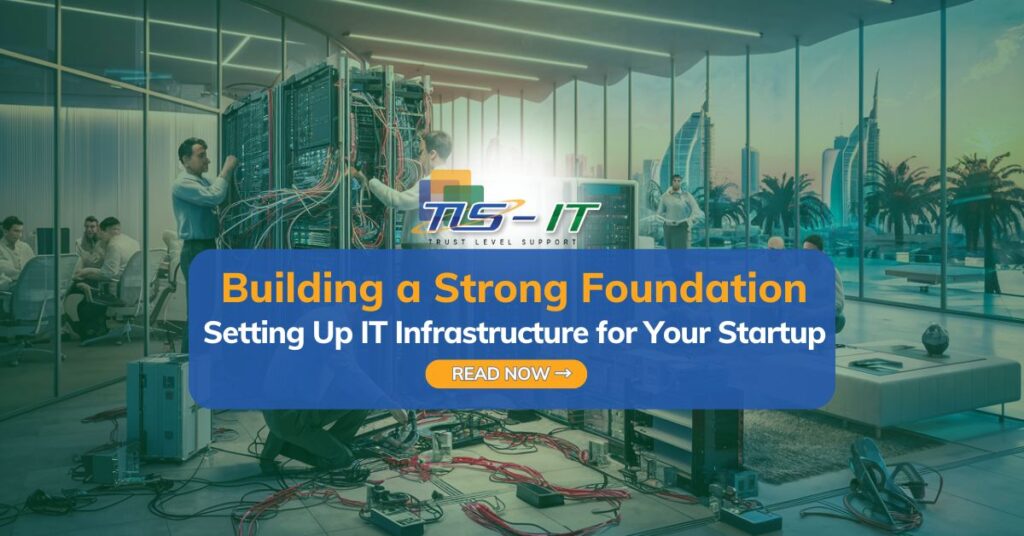In the bustling landscape of Dubai’s business realm, the IT infrastructure stands as the indispensable backbone of enterprises worldwide. In today’s digital age, businesses, regardless of scale or industry, rely heavily on robust IT-enabled systems to function efficiently. This encompasses a spectrum of digital and information technology solutions, incorporating hardware, software, and online components. Particularly for startups and small businesses with limited resources, optimizing every facet of their IT infrastructure becomes imperative for sustainable growth and stability.
The IT infrastructure empowers startups and established businesses alike to deliver essential IT services and solutions to employees, customers, and stakeholders. From managing company emails to facilitating online transactions through websites, the breadth of IT infrastructure is vast, encompassing various critical components. Throughout this blog, we’ll delve into the intricacies of IT infrastructure, exploring essential components and strategies for building a resilient foundation to drive your business forward.
At DMCC, many people ask about the differences in setting up costs among Dubai’s free zones. Knowing these costs is crucial because it impacts whether a particular free zone is suitable for your company. So, in this blog, we’ll break down the expenses involved in forming and running a business in Dubai. Whether you’re just starting to plan or have already set up your company, this guide will offer valuable insights into Dubai’s business expenses.
Planning and Budgeting Your Startup's IT Infrastructure
When setting up your startup’s IT infrastructure, one of the first and most crucial steps is planning and budgeting. While it may seem overwhelming, starting with a list of your requirements is key. From there, decide what can be done using cloud solutions and what needs to be kept in-house. Here are some essential considerations:
- List all your needs.
- Explore both cloud and in-house solutions.
- Think about outsourcing, especially for online components.
- Plan for service and maintenance requirements.
- Estimate costs for each component individually.
- Research solution and service providers thoroughly.
- Look for purchase plans or subscriptions, including bundled packages.
- Estimate maintenance, operational, and renewal costs.
- Consider scaling and future expansion costs for each component.
- Compare different providers, suppliers, and vendors.
This initial step is vital, as it lays the groundwork for your IT infrastructure. Vendors may offer attractive deals for bundled packages, but it’s essential to inquire about scalability and future expansion costs for each item, whether individually or as part of a package.
It’s crucial to ensure scalability. Every software or hardware piece should flex to meet future demands, letting you adjust elements as needed. This boosts efficiency and fosters steady growth, vital for startups and small businesses with limited resources. Prioritizing cost-effective solutions that improve operations sets the stage for profitability and lasting expansion.
Understanding IT Infrastructure Variants:
Harnessing Cloud-Based IT Infrastructure for Startups
Cloud-Based IT Infrastructure presents a modern solution to a longstanding issue. It significantly reduces costs and enables more flexible information flow and data access. With cloud computing, data storage, software, applications, and information are all hosted on online servers. This setup allows startup and small business owners and managers to access data and information from anywhere, whether at home or on the go via smartphone or tablet. All that’s required is a device with internet access to connect to the company network and access everything seamlessly.
Establishing On-Premises IT Infrastructure for Startups
The in-house or on-premises IT infrastructure is a traditional approach where all network devices, storage devices, and servers are physically located within the business facility. This setup is preferred by businesses needing more control over their networks and data management. Setting up on-premises IT infrastructure is straightforward for startups and small businesses and is relatively cost-effective. An entry-level server costs about the same as a regular PC and can typically support up to 25 users, though 10 users per server is often recommended. Additionally, rather than adding more servers, existing servers can be upgraded with additional memory and storage to enhance the network. Routers, network switches, and hubs are also reasonably priced.
Fusing Hybrid IT Infrastructure for Startups
Hybrid IT infrastructure combines elements from both cloud-based and in-house setups, aiming to optimize costs and boost efficiency. This approach allows businesses to blend features from both types of infrastructure, enhancing innovation and functionality. It’s a popular choice across businesses of all sizes, from startups to large enterprises. For instance, systems requiring online access can be hosted on the cloud, while sensitive data and applications can be kept in the in-house setup for enhanced security and privacy.
Email servers, often challenging to maintain on-premises, can be shifted to the cloud, along with websites and customer portals. Conversely, critical tools like ERPs and HRMS may be best hosted on-premises for maximum security and data protection. Building a cost-effective and productive hybrid IT infrastructure requires creativity and a solid understanding of both types of infrastructures.
Outsourcing IT Infrastructure Components for Startups
Outsourcing can offer significant benefits, including cost savings, reduced effort, and time efficiency. For instance, managing an in-house email server demands substantial resources and expensive security measures. Even with cloud-based solutions, both managed and unmanaged options come with high costs. It’s often more advantageous to outsource email services. Similarly, hosting websites and web-based applications is more cost-effective and manageable when entrusted to a reliable IT service provider like TLS IT.
When outsourcing, it’s crucial to choose a company with a strong local presence and a proven track record. A professional outsourcing partner not only reduces costs but also provides hassle-free services while keeping you updated on market trends and innovations. This exposure enables you to stay competitive and make informed improvements that might otherwise be overlooked.
At TLS-IT, we provide tailored solutions for your IT needs, specializing in server setup and selection in Dubai. Our team of specialists handles all server complexities, ensuring seamless installation and ongoing maintenance at competitive rates, delivering exceptional performance and affordability.
Server Options:
- Lenovo
- Huawei
- HP
- Dell
- IBM
Contact us at (+971) 43955877 for configuration assistance. Our experts are available 24/7 to help you. With over 10 years of experience in configuration and reselling, we guarantee top-notch service and support.
The IT Infrastructure is vital for businesses, big or small, serving as its foundation. Data loss incidents leading to business bankruptcies are on the rise, underlining the importance of thoughtful IT infrastructure planning. This blog covers details on in-house, cloud-based, and hybrid IT infrastructures. For startups and small businesses, hybrid setups are often the best choice, offering flexibility. Outsourcing certain components is also a viable option. When planning IT infrastructure, consider both initial and running costs. In-house setups require adequate technical staff for maintenance. Each type of infrastructure has its pros and cons, so weigh them carefully when deciding what to use and what to outsource.




